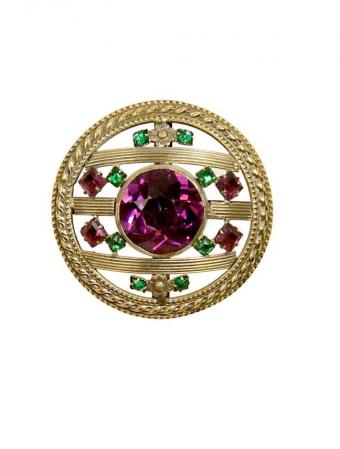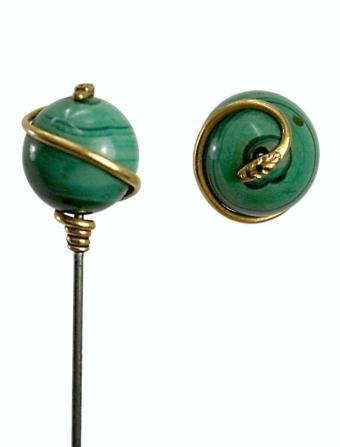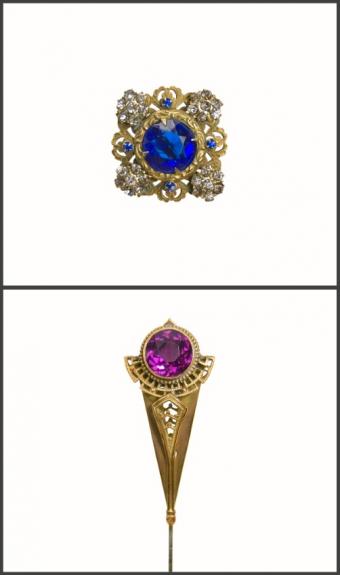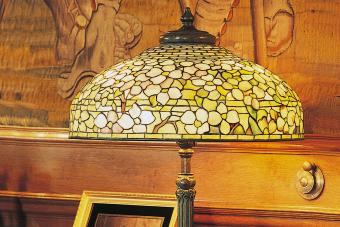Edwardian Hat Pins

Antique stick hat pins became popular as bonnet ribbons went out of style in the 1820s. Women needed some way to secure their hats to their hair and the hat pin was born. In the Edwardian era (1901-1910) hats got quite large and very long hat pins were needed. As the women's suffrage movement became bigger and more volatile, laws were passed to limit the length of a hat pin since it was feared that angry mobs of suffragettes would use the sharp pins as weapons.
This elaborate hat pin clearly shows the graceful Art Noveau lines popular during this time.
Suffragette Hat Pin

Violet, white, and green were the colors chosen to represent the Women's Suffrage Movement and all kinds of jewelry, including hat pins, were created in these colors.
Satsuma Hat Pins

Satsuma hatpins were created in Japan purely for export since Japanese women did not wear hats. These were painstakingly hand painted on porcelain in a variety of motifs. Gold leaf was a popular addition to the design. Pictured are three examples of Japanese Satsuma hat pins.
Egyptian Revival Antique Stick Hat Pin

Antique stick hat pins like this one with the Sphinx on it exemplify the Egyptian Revival style which became popular in the early 20th century. This renewed interest in Egyptian antiquities began as a result of the opening of King Tut's Tomb in 1922.
You can see not only the Egyptian motif, but the trend toward simplicity of design as styles moved toward the sleekness and simplicity of Art Deco.
Carved Ivory

Ivory was a popular material for fashioning all kinds of jewelry, hat pins, and decor. It was legal to import until 1988 and was a popular addition to jewelry throughout most of the 20th century.
Micromosaic Hat Pin

During Victorian times, ladies of means were often sent on a European tour in preparation for settling down into married life with the proper husband. Micromosaic hat pins, like this Italian made example, were bought as mementos of this special time.
Stanho-scope Hat Pins

This tiny barrel is a Stanhope or Stanho-scope . The technique was developed by Rene Dagron in 1857 and allowed tiny images to be viewed inside objects.The viewer was introduced to the general public at the 1859 International Fair in Paris
Inside the barrel is a tiny picture of Niagara Falls and would have been bought as a souvenir. Other items made with this technique included men's stick pins and smoking related items that had pornographic images inside.
Snake Designed Hat Pin

A snake was thought to be a symbol of enduring love and was a popular motif on Victorian hat pins like this one.
Sign up for our newsletter featuring all the latest stories and products we love.
Another Snake Motif

Here is another hat pin with a snake motif. You can see the finding at the base of the pin head, which attached the head to the actual pin stem. Some of these pins could be as much as a foot long.
Detailed Antique Stick Hat Pins

Elaborately detailed hat pins were favored by the affluent ladies of Victorian times. While a shop girl might wear a plain pin with a black bead or similar design, wealthy ladies wore highly detailed pins with their hats.
Hand Painted Portrait

Colonial Revival style included hand painted portraits on hat pins.
Hat pins were popular from about 1850 to about 1920, when the style changed and hats were worn close to the head, flapper style. Rare, unusual, and unique hat pins can command thousands of dollars at auction; even the simpler designs are not cheap. Be careful when you come upon an inexpensive hat pin because there are a lot of fakes and reproductions on the market.
LoveToKnow would like to thank the members of the American Hat Pin Society for providing the images and some of the information in this slideshow.







